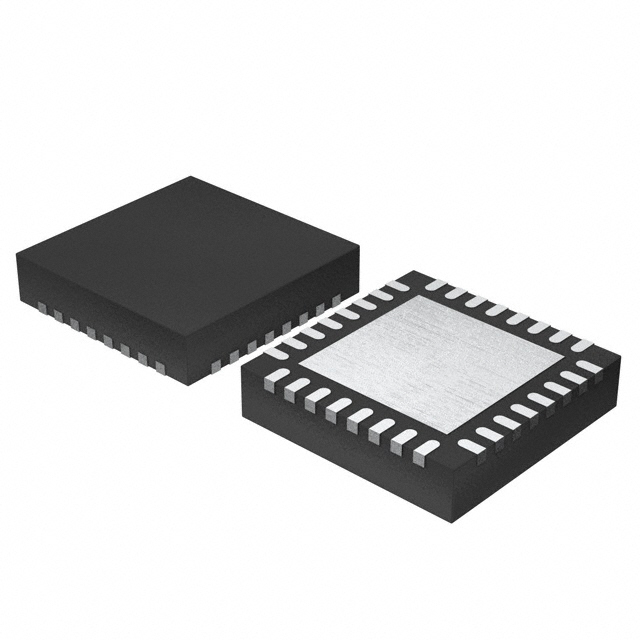Viz Specifikace pro podrobnosti o produktu.

LTC3865EUH#PBF
Product Overview
Category: Power Management ICs
Use: Voltage Regulator
Characteristics: High Efficiency, Synchronous Buck Controller
Package: 32-Lead QFN
Essence: Efficient power conversion and regulation
Packaging/Quantity: Tube/100 pieces
Specifications
- Input Voltage Range: 4.5V to 38V
- Output Voltage Range: 0.6V to 5.5V
- Maximum Output Current: 20A
- Switching Frequency: Up to 2MHz
- Efficiency: Up to 95%
- Operating Temperature Range: -40°C to 125°C
Detailed Pin Configuration
- VIN: Input voltage
- GND: Ground
- FB: Feedback pin for output voltage regulation
- SS: Soft-start capacitor connection
- SYNC: External clock synchronization input
- VCC: Supply voltage for internal control circuitry
- PGND: Power ground
- BOOT: Bootstrap capacitor connection
- SW: Switch node connection
- COMP: Compensation pin for loop stability
- EN: Enable pin for device operation
- RT: Timing resistor connection for switching frequency adjustment
- ITH: Current sense threshold setting
- SS/TRK: Soft-start/tracking capacitor connection
- OCSET: Overcurrent protection threshold setting
- VOUT: Output voltage
Functional Features
- Wide input voltage range allows for versatile applications
- High efficiency ensures minimal power loss during conversion
- Synchronous buck controller provides precise voltage regulation
- Adjustable switching frequency for optimization of performance
- Overcurrent protection safeguards against excessive current flow
- Soft-start feature prevents inrush current during startup
Advantages and Disadvantages
Advantages: - High efficiency results in reduced power consumption - Wide input voltage range enables compatibility with various power sources - Precise voltage regulation ensures stable output - Overcurrent protection enhances system reliability - Soft-start feature prevents damage to components
Disadvantages: - Limited maximum output current may not be suitable for high-power applications - Requires external clock synchronization for certain applications
Working Principles
The LTC3865EUH#PBF is a synchronous buck controller that regulates the output voltage by adjusting the duty cycle of the internal power switches. It operates by converting the input voltage to a lower, regulated output voltage using high-frequency switching. The feedback pin (FB) monitors the output voltage and adjusts the duty cycle accordingly to maintain the desired voltage level. The device also incorporates overcurrent protection to prevent excessive current flow, ensuring the safety of the system.
Detailed Application Field Plans
The LTC3865EUH#PBF is commonly used in various applications such as:
- Industrial equipment power supplies
- Telecom infrastructure
- Automotive electronics
- Distributed power systems
- Battery-powered devices
- LED lighting
Its wide input voltage range, high efficiency, and precise voltage regulation make it suitable for these diverse applications.
Detailed and Complete Alternative Models
- LTC3865EUD#PBF: 24-Lead QFN package, tube/100 pieces
- LTC3865IUH#PBF: 32-Lead QFN package, tube/100 pieces
- LTC3865IUD#PBF: 24-Lead QFN package, tube/100 pieces
- LTC3865EUH#TRPBF: 32-Lead QFN package, tape and reel/2500 pieces
- LTC3865EUD#TRPBF: 24-Lead QFN package, tape and reel/2500 pieces
These alternative models offer similar functionality and characteristics to the LTC3865EUH#PBF, providing flexibility in design choices.
In conclusion, the LTC3865EUH#PBF is a high-efficiency synchronous buck controller that offers precise voltage regulation and overcurrent protection. Its wide input voltage range and compact package make it suitable for various applications in different industries. While it has limitations in terms of maximum output current, there are alternative models available to meet specific requirements.
Seznam 10 běžných otázek a odpovědí souvisejících s aplikací LTC3865EUH#PBF v technických řešeních
Sure! Here are 10 common questions and answers related to the application of LTC3865EUH#PBF in technical solutions:
Q: What is LTC3865EUH#PBF? A: LTC3865EUH#PBF is a high-performance synchronous step-down DC/DC controller IC manufactured by Linear Technology (now part of Analog Devices). It is designed for use in various power supply applications.
Q: What is the input voltage range supported by LTC3865EUH#PBF? A: LTC3865EUH#PBF supports an input voltage range from 4.5V to 38V, making it suitable for a wide range of power supply designs.
Q: What is the output voltage range that can be achieved using LTC3865EUH#PBF? A: The output voltage range of LTC3865EUH#PBF can be adjusted from 0.6V to 5.5V, providing flexibility for different load requirements.
Q: What is the maximum output current that LTC3865EUH#PBF can handle? A: LTC3865EUH#PBF can handle a maximum output current of up to 25A, making it suitable for powering a variety of loads.
Q: Does LTC3865EUH#PBF support synchronous rectification? A: Yes, LTC3865EUH#PBF supports synchronous rectification, which improves efficiency and reduces power losses.
Q: Can LTC3865EUH#PBF operate in a multi-phase configuration? A: Yes, LTC3865EUH#PBF can be configured to operate in a multi-phase configuration, allowing for higher output currents and improved load sharing.
Q: What type of control loop does LTC3865EUH#PBF use? A: LTC3865EUH#PBF uses a voltage mode control loop, which provides good transient response and stability.
Q: Does LTC3865EUH#PBF have built-in protection features? A: Yes, LTC3865EUH#PBF incorporates various protection features such as overvoltage protection (OVP), overcurrent protection (OCP), and thermal shutdown.
Q: Can LTC3865EUH#PBF be synchronized to an external clock? A: Yes, LTC3865EUH#PBF supports external synchronization, allowing for precise timing control in applications that require synchronization with other devices.
Q: What is the package type of LTC3865EUH#PBF? A: LTC3865EUH#PBF is available in a 38-lead exposed pad QFN (Quad Flat No-Lead) package, which provides good thermal performance and ease of PCB layout.
Please note that these answers are general and may vary depending on the specific application and design considerations. It is always recommended to refer to the datasheet and consult with the manufacturer for detailed information and application-specific guidance.

